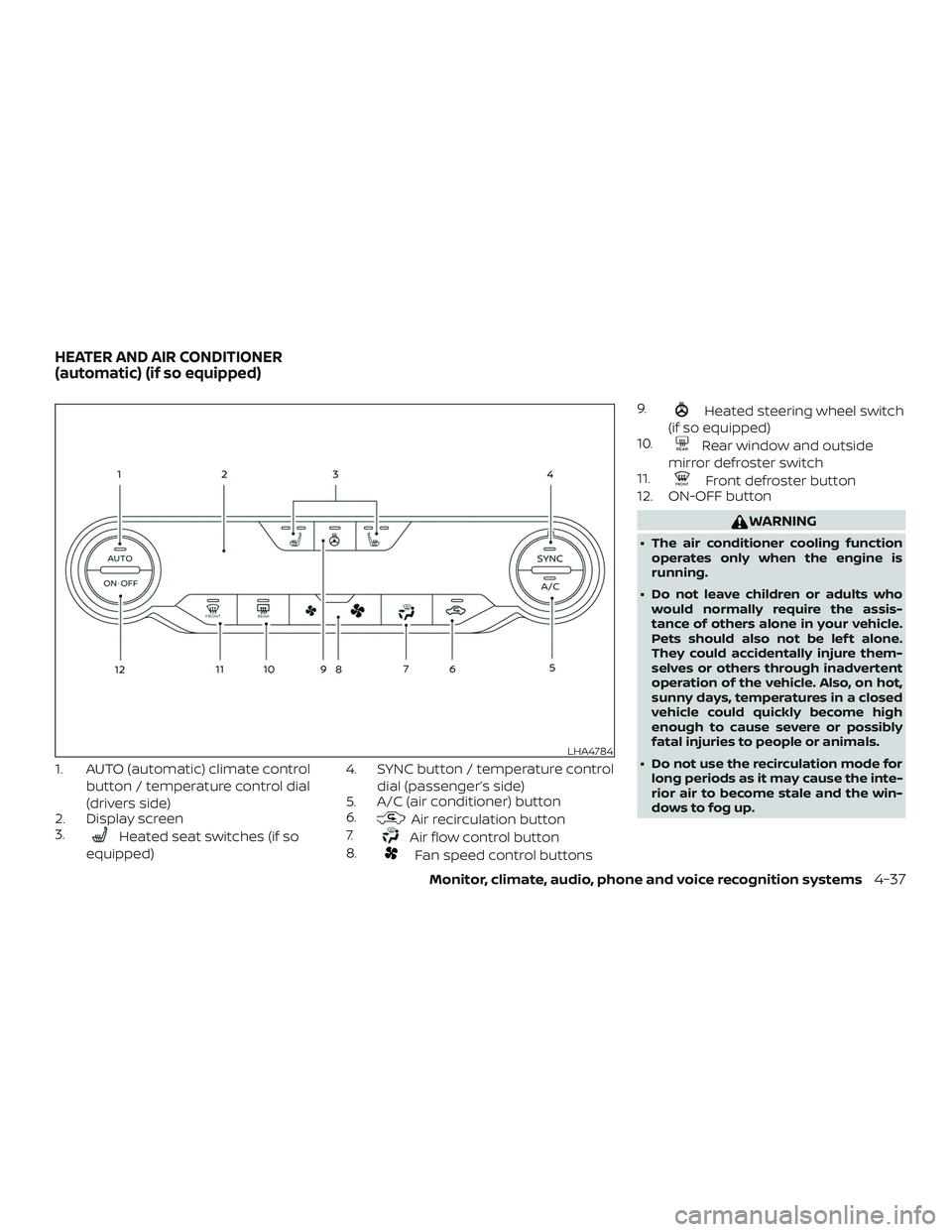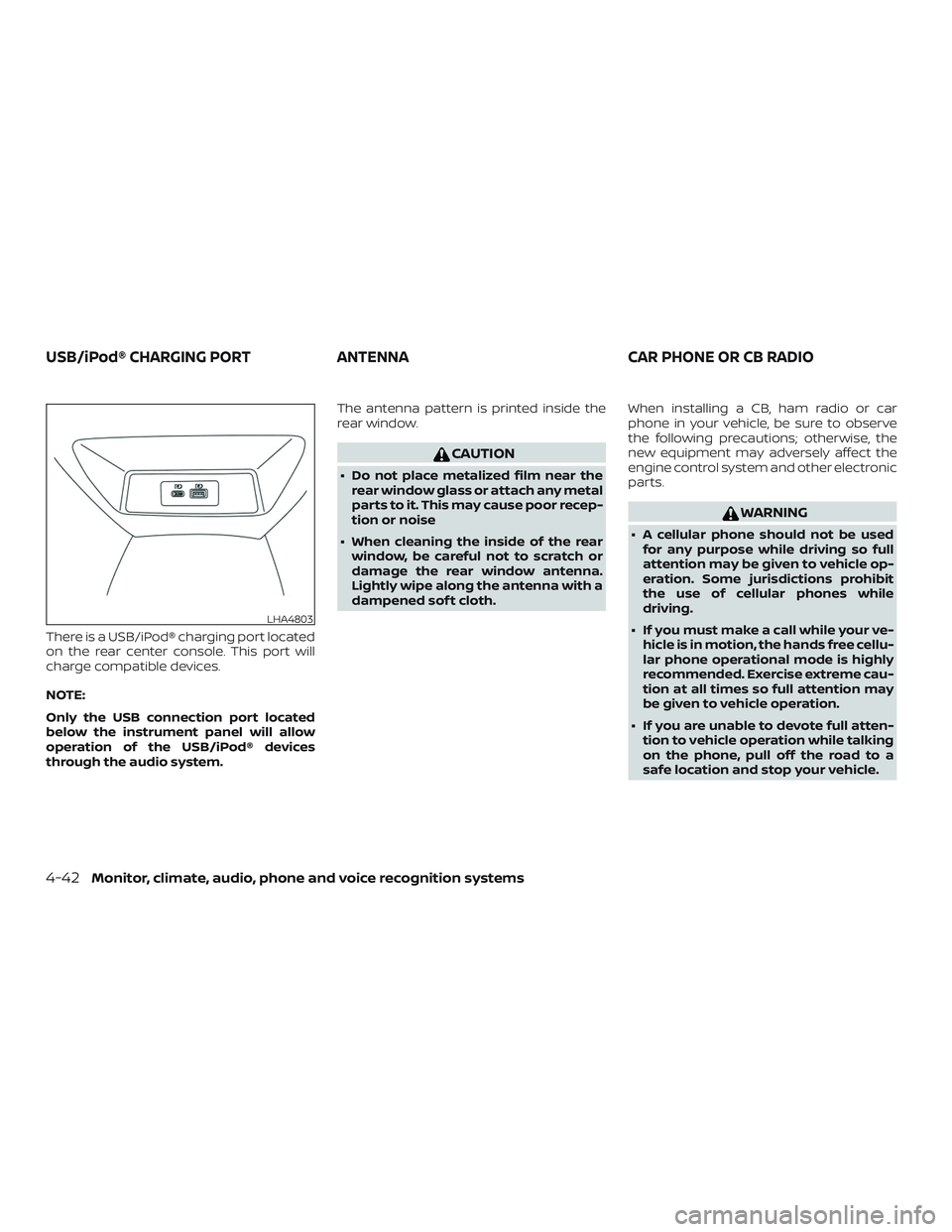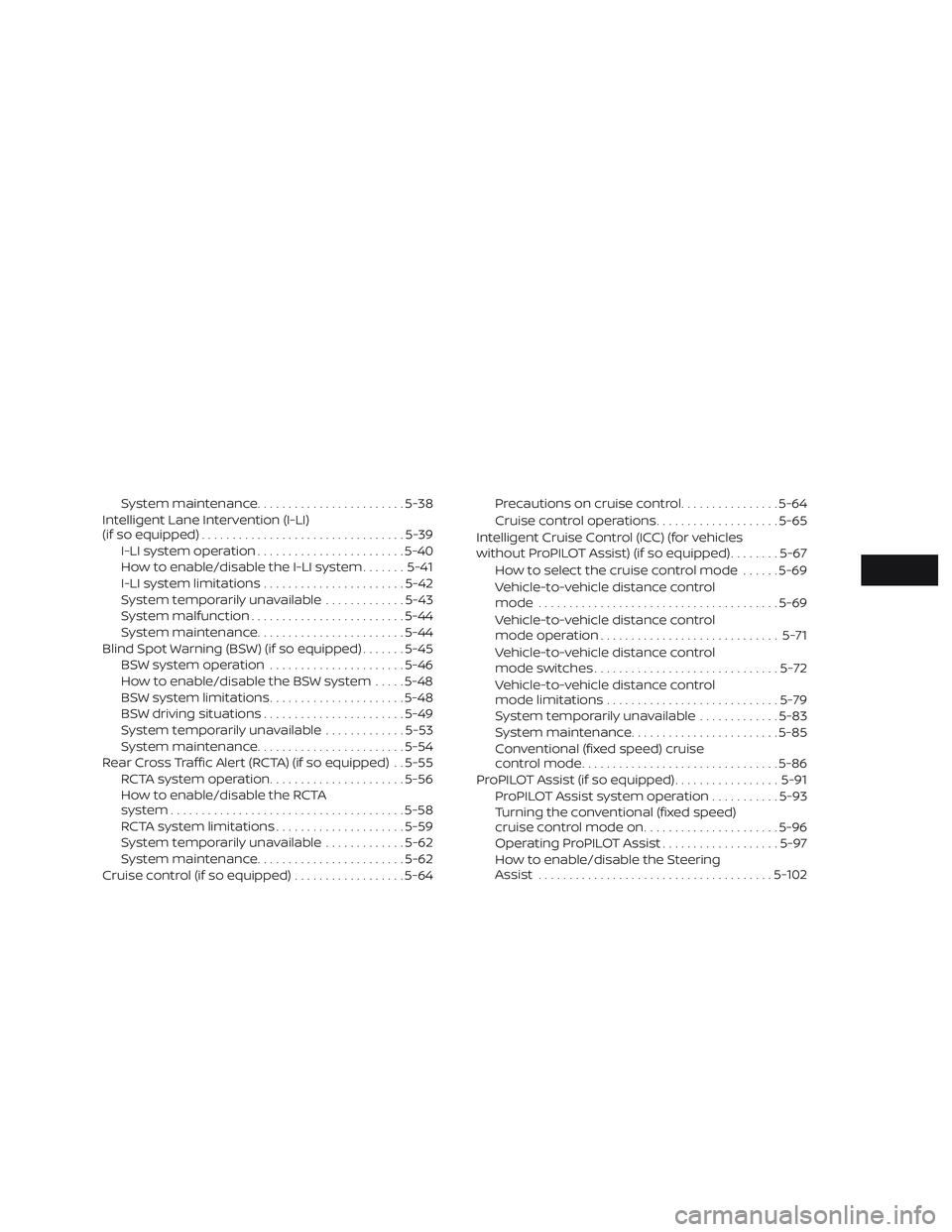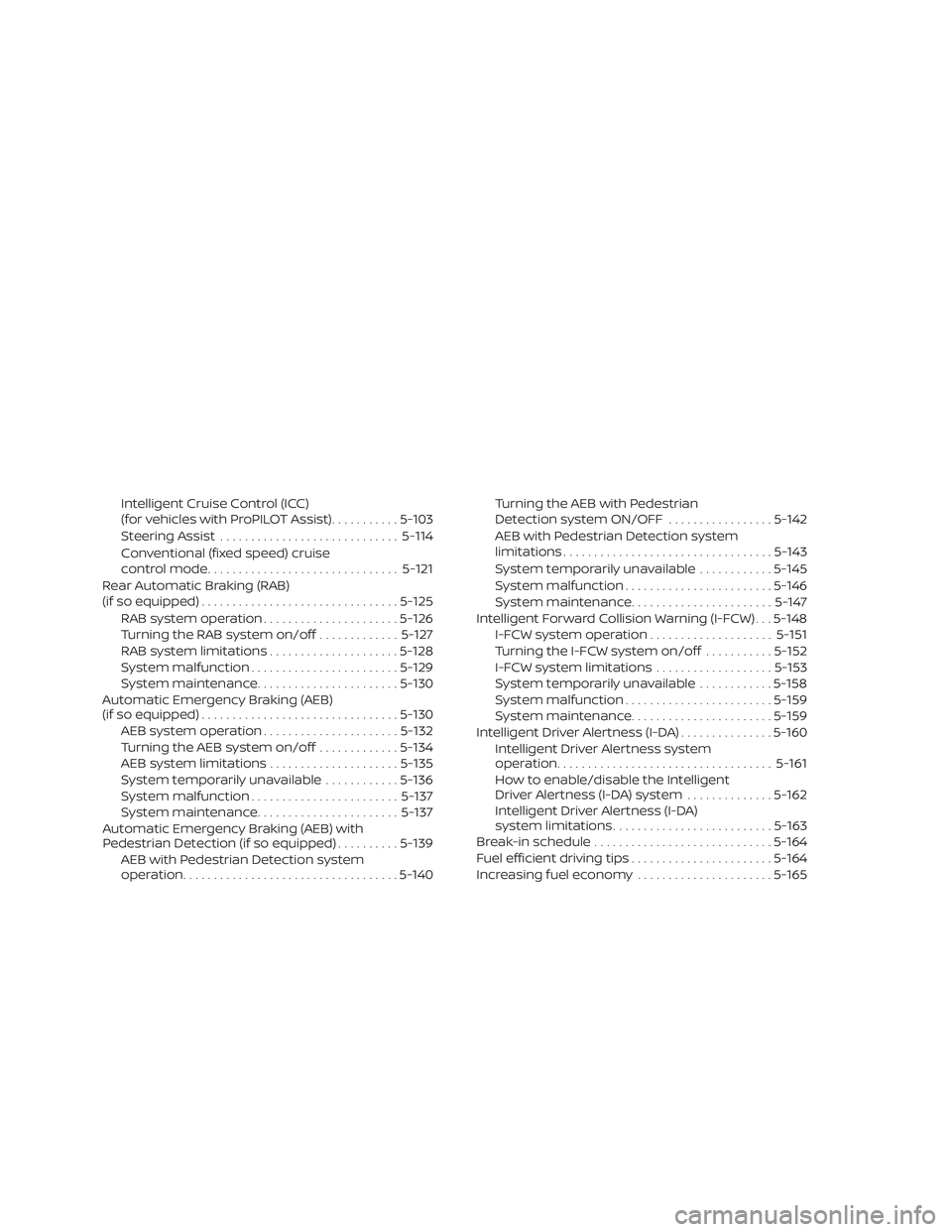2019 NISSAN ALTIMA warning
[x] Cancel search: warningPage 243 of 592

1.Fan speed control dial
2.
Heated seat switches (if so
equipped)
3.
Front defroster button 4.
Rear window and outside
mirror (if so equipped) defroster
switch
5.
Air recirculation button
6. MAX A/C / temperature control dial 7. Air flow control buttons
8. A/C (air conditioner) button
WARNING
∙ The air conditioner cooling function
operates only when the engine is
running.
∙ Do not leave children or adults who would normally require the assis-
tance of others alone in your vehicle.
Pets should also not be lef t alone.
They could accidentally injure them-
selves or others through inadvertent
operation of the vehicle. Also, on hot,
sunny days, temperatures in a closed
vehicle could quickly become high
enough to cause severe or possibly
fatal injuries to people or animals.
∙ Do not use the recirculation mode for long periods as it may cause the inte-
rior air to become stale and the win-
dows to fog up.
NOTE: ∙
Odors from inside and outside the ve-
hicle can build up in the air conditioner
unit. Odor can enter the passenger
compartment through the vents.
LHA4783
HEATER AND AIR CONDITIONER
(manual) (if so equipped)
Monitor, climate, audio, phone and voice recognition systems4-29
Page 251 of 592

1. AUTO (automatic) climate controlbutton / temperature control dial
(drivers side)
2. Display screen
3.
Heated seat switches (if so
equipped) 4. SYNC button / temperature control
dial (passenger’s side)
5. A/C (air conditioner) button
6.
Air recirculation button
7.
Air flow control button
8.
Fan speed control buttons 9.
Heated steering wheel switch
(if so equipped)
10.
Rear window and outside
mirror defroster switch
11.
Front defroster button
12. ON-OFF button
WARNING
∙ The air conditioner cooling function
operates only when the engine is
running.
∙ Do not leave children or adults who would normally require the assis-
tance of others alone in your vehicle.
Pets should also not be lef t alone.
They could accidentally injure them-
selves or others through inadvertent
operation of the vehicle. Also, on hot,
sunny days, temperatures in a closed
vehicle could quickly become high
enough to cause severe or possibly
fatal injuries to people or animals.
∙ Do not use the recirculation mode for long periods as it may cause the inte-
rior air to become stale and the win-
dows to fog up.
LHA4784
HEATER AND AIR CONDITIONER
(automatic) (if so equipped)
Monitor, climate, audio, phone and voice recognition systems4-37
Page 255 of 592

∙ When the climate system is in auto-matic operation and the engine coolant
temperature and outside air tempera-
ture are low, the air flow outlet may de-
fault to defroster mode for a maximum
of 2 minutes 30 seconds. This is not a
malfunction. Af ter the engine coolant
temperature warms up, the air flow out-
let will return to foot mode and opera-
tion will continue normally.
∙ When the outside and interior cabin temperatures are moderate to high, the
intake setting may default to turn off air
recirculation to allow fresh air into the
passenger compartment. You may no-
tice air flow from the foot mode, bi-level
mode, or side demist vent outlets for a
maximum of 15 seconds. This may oc-
cur when the previous climate setting
was turned off. This is not a malfunction.
Af ter the initial warm air is expelled, the
intake will return to automatic control,
the air flow outlet will return to previous
settings, and operation will continue
normally. To exit, press any climate con-
trol button. ∙ Keep the moonroof (if so equipped)
closed while the air conditioner is in op-
eration.
∙ If you feel that the air flow mode you have selected and the outlets the air is
coming out do not match, select
the
mode.
∙ When you change the air flow mode, you may feel air flow from the foot out-
lets for just a moment. This is not a
malfunction. The air conditioner system in your NISSAN
vehicle is charged with a refrigerant de-
signed with the environment in mind.
This refrigerant does not harm the
earth’s ozone layer.
Special charging equipment and lubricant
is required when servicing your NISSAN air
conditioner. Using improper refrigerants or
lubricants will cause severe damage to
your air conditioner system. For additional
information, refer to “Air conditioner sys-
tem refrigerant and oil recommendations”
in the “Technical and consumer informa-
tion” section of this manual.
It is recommended that you visit a NISSAN
dealer to service your “environmentally
friendly” air conditioner system.
WARNING
The air conditioner system contains re-
frigerant under high pressure. To avoid
personal injury, any air conditioner ser-
vice should be done only by an experi-
enced technician with proper equipment.
SERVICING AIR CONDITIONER
Monitor, climate, audio, phone and voice recognition systems4-41
Page 256 of 592

There is a USB/iPod® charging port located
on the rear center console. This port will
charge compatible devices.
NOTE:
Only the USB connection port located
below the instrument panel will allow
operation of the USB/iPod® devices
through the audio system.The antenna pattern is printed inside the
rear window.
CAUTION
∙ Do not place metalized film near the
rear window glass or attach any metal
parts to it. This may cause poor recep-
tion or noise
∙ When cleaning the inside of the rear window, be careful not to scratch or
damage the rear window antenna.
Lightly wipe along the antenna with a
dampened sof t cloth. When installing a CB, ham radio or car
phone in your vehicle, be sure to observe
the following precautions; otherwise, the
new equipment may adversely affect the
engine control system and other electronic
parts.
WARNING
∙ A cellular phone should not be used
for any purpose while driving so full
attention may be given to vehicle op-
eration. Some jurisdictions prohibit
the use of cellular phones while
driving.
∙ If you must make a call while your ve- hicle is in motion, the hands free cellu-
lar phone operational mode is highly
recommended. Exercise extreme cau-
tion at all times so full attention may
be given to vehicle operation.
∙ If you are unable to devote full atten- tion to vehicle operation while talking
on the phone, pull off the road to a
safe location and stop your vehicle.
LHA4803
USB/iPod® CHARGING PORT ANTENNACAR PHONE OR CB RADIO
4-42Monitor, climate, audio, phone and voice recognition systems
Page 258 of 592

5 Starting and driving
Precautions when starting and driving..........5-4
Exhaust gas (carbon monoxide) ..............5-4
Three-way catalyst ...........................5-4
Tire Pressure Monitoring System
(TPMS)........................................5-5
Avoiding collision and rollover ................5-9
Off-roadrecovery ............................5-9
Rapid air pressure loss .......................5-9
Drinking alcohol/drugs and driving ..........5-10
Driving safety precautions ....................5-11
Push-button ignition switch ....................5-13
Operating range ............................. 5-14
Push-button ignition switch positions .......5-14
Emergency engine shut off ..................5-15
NISSAN Intelligent Key® battery
discharge ................................... 5-15
NISSAN Vehicle Immobilizer System .........5-16
Before starting the engine ......................5-16
Starting the engine ............................. 5-17
Remote Engine Start (if so equipped) ........5-18
Driving the vehicle .............................. 5-18
Continuously Variable Transmission
(CVT) ........................................ 5-18Parking brake
.................................. 5-25
Pedal type ................................... 5-26
Switch type (models with electronic
parking brake system) .......................5-26
Automatic brake hold (if so equipped) ..........5-28
How to activate/deactivate the
automatic brake hold function ..............5-29
How to use the automatic brake hold
function ..................................... 5-30
Traffic Sign Recognition (TSR) (if so equipped) . . . 5-31 System operation ........................... 5-32
Turning the Traffic Sign Recognition
(TSR) system on and off .....................5-33
System temporarily unavailable .............5-33
System malfunction ......................... 5-33
System maintenance ........................ 5-34
Lane Departure Warning (LDW)
(if so equipped) ................................. 5-34
LDW system operation ......................5-35
How to enable/disable the LDW system .....5-36
LDW system limitations ......................5-36
S
ystem temporarily unavailable .............5-37
System malfunction ......................... 5-38
Page 259 of 592

System maintenance........................ 5-38
Intelligent Lane Intervention (I-LI)
(if so equipped) ................................. 5-39
I-LI system operation ........................ 5-40
How to enable/disable the I-LI system .......5-41
I-LI system limitations .......................5-42
System temporarily unavailable .............5-43
System malfunction ......................... 5-44
System maintenance ........................ 5-44
Blind Spot Warning (BSW) (if so equipped) .......5-45
BSW system operation ......................5-46
How to enable/disable the BSW system .....5-48
BSW system limitations ......................5-48
BSW driving situations .......................5-49
System temporarily unavailable .............5-53
System maintenance ........................ 5-54
Rear Cross Traffic Alert (RCTA) (if so equipped) . . 5-55 RCTA system operation ......................5-56
How to enable/disable the RCTA
system ...................................... 5-58
RCTA system limitations .....................5-59
System temporarily unavailable .............5-62
System maintenance ........................ 5-62
Cruise control (if so equipped) ..................5-64Precautions on cruise control
................5-64
Cruise control operations ....................5-65
Intelligent Cruise Control (ICC) (for vehicles
without ProPILOT Assist) (if so equipped) ........5-67
How to select the cruise control mode ......5-69
Vehicle-to-vehicle distance control
mode ....................................... 5-69
Vehicle-to-vehicle distance control
mode operation ............................. 5-71
Vehicle-to-vehicle distance control
mode switches .............................. 5-72
Vehicle-to-vehicle distance control
mode limitations ............................ 5-79
System temporarily unavailable .............5-83
System maintenance ........................ 5-85
Conventional (fixed speed) cruise
c
ontrol mode ................................ 5-86
ProPILOT Assist (if so equipped) .................5-91
ProPILOT Assist system operation ...........5-93
Turning the conventional (fixed speed)
cruise control mode on ......................5-96
Operating ProPILOT Assist ...................5-97
How to enable/disable the Steering
Assist ...................................... 5-102
Page 260 of 592

Intelligent Cruise Control (ICC)
(for vehicles with ProPILOT Assist)...........5-103
Steering Assist ............................. 5-114
Conventional (fixed speed) cruise
control mode ............................... 5-121
Rear Automatic Braking (RAB)
(if so equipped) ................................ 5-125
RAB system operation ......................5-126
Turning the RAB system on/off .............5-127
RAB system limitations .....................5-128
System malfunction ........................ 5-129
System maintenance ....................... 5-130
Automatic Emergency Braking (AEB)
(if so equipped) ................................ 5-130
AEB system operation ......................5-132
Turning the AEB system on/off .............5-134
AEB system limitations .....................5-135
System temporarily unavailable ............5-136
System malfunction ........................ 5-137
System maintenance ....................... 5-137
Automatic Emergency Braking (AEB) with
Pedestrian Detection (if so equipped) ..........5-139
AEB with Pedestrian Detection system
operation ................................... 5-140Turning the AEB with Pedestrian
Detection system ON/OFF
.................5-142
AEB with Pedestrian Detection system
limitations .................................. 5-143
System temporarily unavailable ............5-145
System malfunction ........................ 5-146
System maintenance ....................... 5-147
Intelligent Forward Collision Warning (I-FCW) . . . 5-148 I-FCW system operation ....................5-151
Turning the I-FCW system on/off ...........5-152
I-FCW system limitations ...................5-153
System temporarily unavailable ............5-158
System malfunction ........................ 5-159
System maintenance ....................... 5-159
Intelligent Driver Alertness (I-DA) ...............5-160
Intelligent Driver Alertness system
operation ................................... 5-161
How
to enable/disable the Intelligent
Driver Alertness (I-DA) system ..............5-162
Intelligent Driver Alertness (I-DA)
system limitations .......................... 5-163
Break-in schedule ............................. 5-164
Fuel efficient driving tips .......................5-164
Increasing fuel economy ......................5-165
Page 262 of 592

WARNING
∙ Do not leave children or adults whowould normally require the assis-
tance of others alone in your vehicle.
Pets should also not be lef t alone.
They could accidentally injure them-
selves or others through inadvertent
operation of the vehicle. Also, on hot,
sunny days, temperatures in a closed
vehicle could quickly become high
enough to cause severe or possibly
fatal injuries to people or animals.
∙ Closely supervise children when they are around cars to prevent them from
playing and becoming locked in the
trunk where they could be seriously
injured. Keep the car locked, with the
rear seatback and trunk lid securely
latched when not in use, and prevent
children’s access to car keys.
EXHAUST GAS (carbon monoxide)
WARNING
∙ Do not breathe exhaust gases; theycontain colorless and odorless carbon
monoxide. Carbon monoxide is dan-
gerous. It can cause unconsciousness
or death. ∙ If you suspect that exhaust fumes are
entering the vehicle, drive with all
windows fully open, and have the ve-
hicle inspected immediately.
∙ Do not run the engine in closed spaces such as a garage.
∙ Do not park the vehicle with the en- gine running for any extended length
of time.
∙ Keep the rear vent windows, lif tgates, doors and trunk lids (if so equipped)
closed while driving, otherwise ex-
haust gases could be drawn into the
passenger compartment. If you must
drive with one of these open, follow
these precautions:
1. Open all the windows.
2. Set the
air recirculation but-
ton to off and the fan control dial to
high to circulate the air.
∙ If electrical wiring or other cable con- nections must pass to a trailer
through the seal on the trunk lid or the
body, follow the manufacturer’s rec-
ommendation to prevent carbon
monoxide entry into the vehicle. ∙ The exhaust system and body should
be inspected by a qualified mechanic
whenever:
a. The vehicle is raised for service.
b. You suspect that exhaust fumes are entering into the passenger
compartment.
c. You notice a change in the sound of the exhaust system.
d. You have had an accident involving damage to the exhaust system,
underbody, or rear of the vehicle.
THREE-WAY CATALYST
The three-way catalyst is an emission con-
trol device installed in the exhaust system.
Exhaust gases in the three-way catalyst
are burned at high temperatures to help
reduce pollutants.
WARNING
∙The exhaust gas and the exhaust sys-
tem are very hot. Keep people, animals
or flammable materials away from the
exhaust system components.
PRECAUTIONS WHEN STARTING AND
DRIVING
5-4Starting and driving